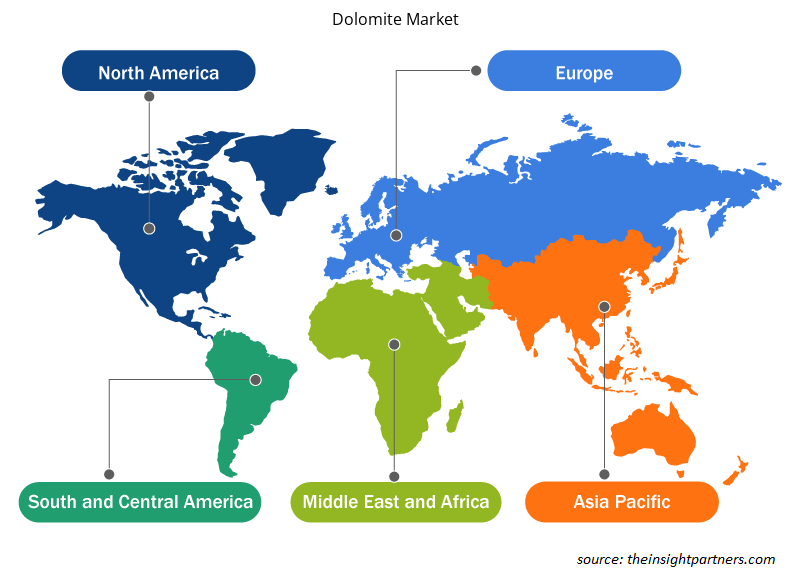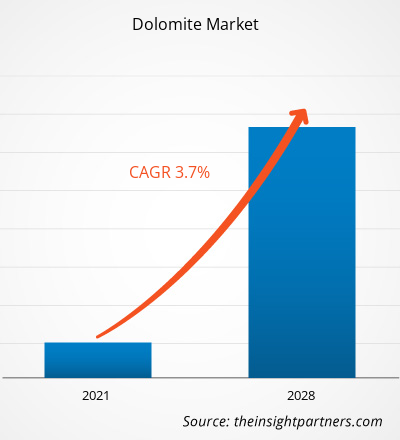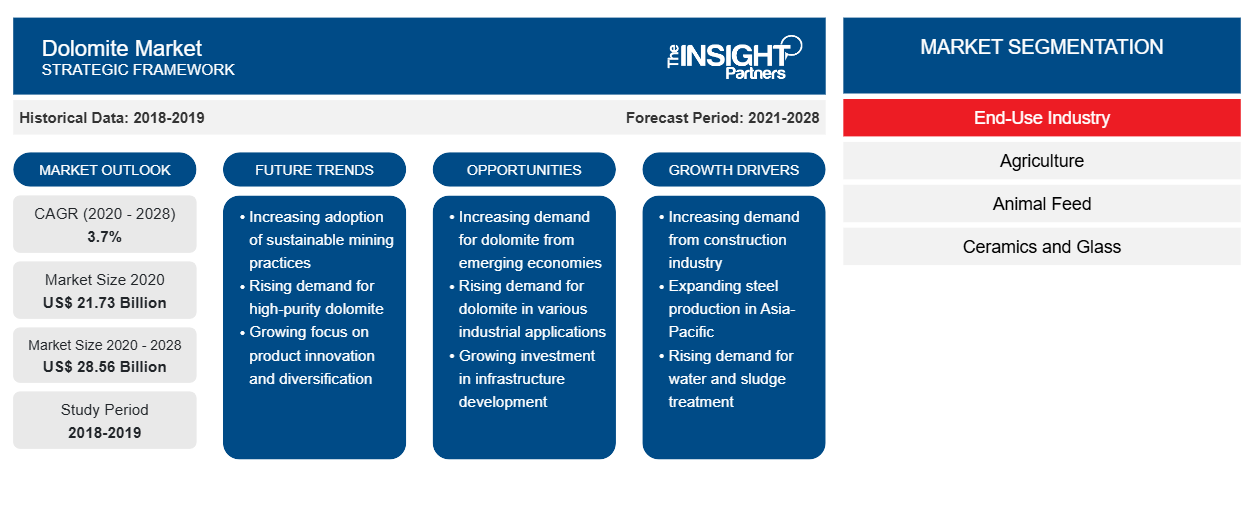Se proyecta que el mercado de dolomita crecerá de US$ 21.727,97 millones en 2020 a US$ 28.558,14 millones en 2028; se espera que crezca a una CAGR del 3,7% durante 2021-2028.
La dolomita es un material importante para las industrias de ferroaleaciones y se utiliza ampliamente en plantas de hierro y acero. También tiene una aplicación vital en el sector agrícola debido a su capacidad para actuar como acondicionador del suelo y equilibrar el pH del suelo. El petróleo y el gas, los productos químicos, el caucho, la minería y los metales, el tratamiento del agua, los productos farmacéuticos y los cosméticos se encuentran entre otros usuarios finales importantes de esta sustancia. Como estas industrias están experimentando un crecimiento considerable, especialmente en las economías en desarrollo, la demanda de dolomita también está creciendo continuamente. Sin embargo, los efectos adversos de las actividades mineras sobre el medio ambiente siguen siendo una preocupación para los productores de dolomita.
En 2020, Asia Pacífico tuvo la mayor participación en los ingresos del mercado mundial de dolomita . El rápido crecimiento de la industrialización está impulsando las inversiones en infraestructura de transporte en esta región. Además, un aumento en la producción de refractarios está impulsando la demanda de dolomita en las industrias del hierro y el acero en Asia Pacífico. La región alberga las economías más grandes, como China e India, que se encuentran entre los mayores consumidores de refractarios del mundo. China es un importante productor de acero en el mundo, mientras que India está experimentando un crecimiento exponencial en infraestructura. Por lo tanto, estos factores están brindando varias oportunidades de crecimiento para los actores del mercado de dolomita en la región.
Personalice este informe según sus necesidades
Obtendrá personalización en cualquier informe, sin cargo, incluidas partes de este informe o análisis a nivel de país, paquete de datos de Excel, así como también grandes ofertas y descuentos para empresas emergentes y universidades.
-
Obtenga las principales tendencias clave del mercado de este informe.Esta muestra GRATUITA incluirá análisis de datos, desde tendencias del mercado hasta estimaciones y pronósticos.
Impacto de la pandemia de COVID-19 en el mercado de dolomita
La actual pandemia de COVID-19 ha alterado drásticamente el estado del sector químico y de materiales y ha afectado negativamente al crecimiento del mercado de la minería de dolomita. La implementación de medidas para combatir la propagación del SARS-CoV-2 ha agravado la situación. Industrias como la construcción y el hierro y el acero se han visto afectadas por la repentina distorsión de la eficiencia operativa y las interrupciones en las cadenas de valor atribuibles al cierre repentino de las fronteras nacionales e internacionales. Una disminución significativa en el crecimiento de los diversos sectores industriales ha llevado a una menor demanda de dolomita. El cierre de las operaciones mineras ha creado un rendimiento de producción anual obstaculizado. Los efectos a largo plazo de la pandemia de COVID-19 en la industria minera dependerán de la duración de los períodos de cierre y de la capacidad de los actores de la industria para resurgir. Como muchos países están planeando reactivar sus operaciones, se espera que la demanda de dolomita aumente a nivel mundial en los próximos meses. Los actores del mercado de la minería de dolomita se están centrando en la disponibilidad de suministros y mano de obra para alcanzar niveles operativos completos.
Perspectivas del mercado
Amplia gama de aplicaciones de dolomita para impulsar el crecimiento del mercado de dolomita
La dolomita tiene una amplia gama de aplicaciones en industrias de usuarios finales como la construcción, el hierro y el acero, las ferroaleaciones, la cerámica y el vidrio, la agricultura y la alimentación animal. Su preferencia y adopción en las industrias depende del grado de la roca. La dolomita es una sustancia de uso común en la industria de la construcción debido a su dureza y densidad. En la industria del hierro y el acero, la dolomita se utiliza en tres formas: dolomita en bruto, dolomita calcinada y dolomita sinterizada. La dolomita se utiliza para la neutralización de ácidos en las industrias químicas y en proyectos de restauración de arroyos. También se utiliza como fuente de magnesia (MgO), un aditivo alimentario para el ganado. La dolomita se utiliza en la fabricación de vidrio para automóviles, vidrio para la construcción, fibra de vidrio, etc. Por lo tanto, con el crecimiento de varias industrias de usuarios finales, como la construcción, el hierro y el acero, la cerámica y el vidrio, la demanda de dolomita también está creciendo.
Perspectivas de la industria de uso final
Según la industria de uso final, el mercado mundial de dolomita se segmenta en agricultura, piensos para animales, cerámica y vidrio, hierro y acero, construcción y otros. El segmento de hierro y acero tuvo la mayor participación del mercado en 2020. La industria del hierro y el acero está fuertemente impulsada por el crecimiento de segmentos como defensa, ingeniería pesada, energía y construcción. La demanda cada vez mayor de estos sectores debido a la rápida urbanización e industrialización, especialmente en regiones en desarrollo como Asia Pacífico y América del Sur y Central, es un factor importante que contribuye a la alta demanda de dolomita en el mundo, lo que está impulsando el crecimiento del mercado.
Algunos de los actores clave en el mercado global de dolomita son Beihai Group; Calcinor; Essel Mining & Industries Limited; JFE GROUP; INCA MINING; LHOIST GROUP; Sibelco; RHI Magnesita GmbH; Arihant Min chem; y Omya AG.
Perspectivas regionales del mercado de dolomita
Los analistas de Insight Partners explicaron en detalle las tendencias y los factores regionales que influyen en el mercado de dolomita durante el período de pronóstico. Esta sección también analiza los segmentos y la geografía del mercado de dolomita en América del Norte, Europa, Asia Pacífico, Oriente Medio y África, y América del Sur y Central.

- Obtenga los datos regionales específicos para el mercado de dolomita
Alcance del informe sobre el mercado de dolomita
| Atributo del informe | Detalles |
|---|---|
| Tamaño del mercado en 2020 | US$ 21,73 mil millones |
| Tamaño del mercado en 2028 | US$ 28,56 mil millones |
| Tasa de crecimiento anual compuesta (CAGR) global (2020-2028) | 3,7% |
| Datos históricos | 2018-2019 |
| Período de pronóstico | 2021-2028 |
| Segmentos cubiertos |
Por industria de uso final
|
| Regiones y países cubiertos |
América del norte
|
| Líderes del mercado y perfiles de empresas clave |
|
Densidad de actores del mercado de dolomita: comprensión de su impacto en la dinámica empresarial
El mercado de dolomita está creciendo rápidamente, impulsado por la creciente demanda de los usuarios finales debido a factores como la evolución de las preferencias de los consumidores, los avances tecnológicos y una mayor conciencia de los beneficios del producto. A medida que aumenta la demanda, las empresas amplían sus ofertas, innovan para satisfacer las necesidades de los consumidores y aprovechan las tendencias emergentes, lo que impulsa aún más el crecimiento del mercado.
La densidad de actores del mercado se refiere a la distribución de las empresas o firmas que operan dentro de un mercado o industria en particular. Indica cuántos competidores (actores del mercado) están presentes en un espacio de mercado determinado en relación con su tamaño o valor total de mercado.
Las principales empresas que operan en el mercado de la dolomita son:
- Grupo Beihai
- Calcinor
- Essel Minería e Industrias Limitada
- GRUPO JFE
- MINERÍA INCA
Descargo de responsabilidad : Las empresas enumeradas anteriormente no están clasificadas en ningún orden particular.

- Obtenga una descripción general de los principales actores clave del mercado de dolomita
Informe Destacado
- Tendencias progresivas de la industria en el mercado de dolomita para ayudar a los actores a desarrollar estrategias efectivas a largo plazo
- Estrategias de crecimiento empresarial adoptadas por los mercados desarrollados y en desarrollo
- Análisis cuantitativo del mercado de dolomita de 2019 a 2028
- Estimación de la demanda mundial de dolomita
- Análisis de las cinco fuerzas de Porter para ilustrar la eficacia de los compradores y proveedores en la industria
- Avances recientes para comprender el escenario competitivo del mercado
- Tendencias y perspectivas del mercado, así como factores que rigen el crecimiento del mercado de dolomita
- Asistencia en el proceso de toma de decisiones destacando las estrategias de mercado que sustentan el interés comercial y conducen al crecimiento del mercado.
- Tamaño del mercado de dolomita en varios nodos
- Descripción general detallada del mercado y segmentación, y dinámica de la industria de la dolomita
- Tamaño del mercado de dolomita en varias regiones con prometedoras oportunidades de crecimiento
El mercado mundial de dolomita se ha segmentado de la siguiente manera:
Por industria de uso final
- Agricultura
- Alimento para animales
- Cerámica y vidrio
- Hierro y acero
- Construcción
- Otros
Perfiles de empresas
- Grupo Beihai
- Calcinor
- Essel Minería e Industrias Limitada
- GRUPO JFE
- MINERÍA INCA
- GRUPO LHOIST
- Sibelco
- RHI Magnesita GmbH
- Química Arihant Min
- Omya AG
- Análisis histórico (2 años), año base, pronóstico (7 años) con CAGR
- Análisis PEST y FODA
- Tamaño del mercado, valor/volumen: global, regional y nacional
- Industria y panorama competitivo
- Conjunto de datos de Excel
Informes recientes
Testimonios
Razón para comprar
- Toma de decisiones informada
- Comprensión de la dinámica del mercado
- Análisis competitivo
- Información sobre clientes
- Pronósticos del mercado
- Mitigación de riesgos
- Planificación estratégica
- Justificación de la inversión
- Identificación de mercados emergentes
- Mejora de las estrategias de marketing
- Impulso de la eficiencia operativa
- Alineación con las tendencias regulatorias























 Obtenga una muestra gratuita para - Mercado de dolomitas
Obtenga una muestra gratuita para - Mercado de dolomitas